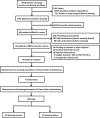Effect of Tracheostomy on Weaning Parameters in Difficult-to-Wean Mechanically Ventilated Patients: A Prospective Observational Study
- PMID: 26379127
- PMCID: PMC4574918
- DOI: 10.1371/journal.pone.0138294
Effect of Tracheostomy on Weaning Parameters in Difficult-to-Wean Mechanically Ventilated Patients: A Prospective Observational Study
Abstract
Background and objective: Weaning parameters are commonly measured through an endotracheal tube in mechanically ventilated patients recovering from acute respiratory failure, however this practice has rarely been evaluated in tracheostomized patients. This study aimed to investigate changes in weaning parameters measured before and after tracheostomy, and to explore whether the data measured after tracheostomy were associated with weaning outcomes in difficult-to-wean patients.
Methods: In a two-year study period, we enrolled orotracheally intubated patients who were prepared for tracheostomy due to difficult weaning. Weaning parameters were measured before and after the conversion to tracheostomy and compared, and the post-tracheostomy data were tested for associations with weaning outcomes.
Results: A total of 86 patients were included. After tracheostomy, maximum inspiratory pressure (mean difference (Δ) = 4.4, 95% CI, 2.7 to 6.1, P<0.001), maximum expiratory pressure (Δ = 5.4, 95% CI, 2.9 to 8.0, P<0.001) and tidal volume (Δ = 33.7, 95% CI, 9.0 to 58.5, P<0.008) significantly increased, and rapid shallow breathing index (Δ = -14.6, 95% CI, -25.4 to -3.7, P<0.009) and airway resistance (Δ = -4.9, 95% CI, -5.8 to -4.0, P<0.001) significantly decreased. The patients who were successfully weaned within 90 days of the initiation of mechanical ventilation had greater increments in maximum inspiratory pressure (5.9 vs. 2.4, P = 0.04) and maximum expiratory pressure (8.0 vs. 2.0, P = 0.02) after tracheostomy than those who were unsuccessfully weaned.
Conclusions: In conclusion, the conversion from endotracheal tube to tracheostomy significantly improved the measured values of weaning parameters in difficult-to-wean patients who subsequently weaned successfully from the mechanical ventilator. The change was significant only for airway resistance in patients who failed weaning.
Trial registration: ClinicalTrials.gov NCT01312142.
Conflict of interest statement
Figures



References
Publication types
MeSH terms
Associated data
LinkOut - more resources
Full Text Sources
Other Literature Sources
Medical

